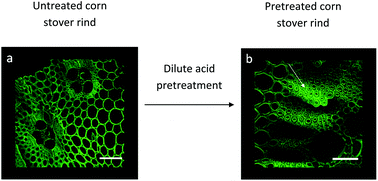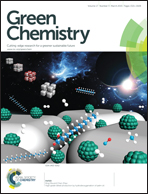Investigation of the role of lignin in biphasic xylan hydrolysis during dilute acid and organosolv pretreatment of corn stover†
Abstract
One of the key objectives of biomass pretreatment is to maximize the xylose yield. However, the kinetics of xylan hydrolysis appear to be governed by two parallel first-order reactions with one reaction much faster than the other, thereby limiting both the rate and extent of xylan hydrolysis. Here, we investigate the influence of lignin on xylan hydrolysis kinetics during dilute acid pretreatment of corn stover rind (CSR) by modifying either the substrate or the pretreatment conditions. Dilute acid pretreatment was conducted to test the hypothesis that association of a fraction of the xylan with lignin causes this fraction to hydrolyze at a slower rate resulting in biphasic kinetics. In addition, CSR was pretreated under organosolv (OS) conditions, where xylan and lignin were solubilized simultaneously, to decouple the hydrolysis of xylan from the lignin redistribution process that occurs during dilute acid pretreatment. Dilute acid pretreatment of CSR delignified under mild conditions still exhibited biphasic kinetics, although the fraction of slow hydrolyzing xylan decreased and the rate of fast hydrolyzing xylan increased by 60% resulting in achieving more than 95% total xylose yield. Pretreatment of CSR under OS conditions also appeared to exhibit biphasic xylan hydrolysis kinetics. Unexpectedly, the solubilization of xylan and lignin appeared to occur at similar rates. The increases in the rate and fraction of fast hydrolyzing xylan observed by removing the majority of the lignin support the hypothesis that the slow hydrolyzing xylan is a result of its association with lignin. To further investigate the role of lignin in xylan hydrolysis, the raw and pretreated CSR samples were labeled with a monoclonal antibody (containing a fluorescent dye) that binds xylan specifically so that the location of xylan in the cell wall could be imaged by confocal laser scanning microscopy (CLM). CLM of the pretreated delignified samples showed a similar, intense signal pattern as exhibited by the raw and pretreated control, indicating that the majority of the remaining xylan was located at both cytosolic and middle lamellar cell wall edges. OS pretreated CSR did, however, show a diminution in signal intensity at cell wall edges compared to CSR pretreated under standard dilute acid conditions.


 Please wait while we load your content...
Please wait while we load your content...